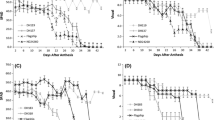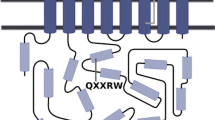Abstract
The plant hormone ethylene is important to many plant processes from germination through senescence, including responses to in vitro growth and plant regeneration. Knowledge of the number and function of genes that are involved in ethylene biosynthesis and reception is necessary to determine the role of specific genes within gene families known to influence ethylene biosynthesis and other aspects of ethylene function in plants. Our objective was built on previous studies that have established the critical role of ethylene in the in vitro response of barley (Hordeum vulgare L.), and that have identified ethylene-related QTL in the barley genome. In this study, we have identified the locations of genes in the barley 1-aminocyclopropane-1-carboxylic acid (ACC) synthase (ACS), ACC oxidase (ACO), and ethylene receptor (ETR) gene families. Specific primers for PCR amplification of each gene were developed and used to map these genes in the Oregon Wolf Barley mapping population. Five ACS, 8 ACO, and 7 ETR genes were identified and mapped to six of the barley chromosomes. Gene locations were syntenous to the orthologs in rice except for two that mapped to chromosome 6H. Gene duplication was evident for ACO genes on chromosomes 5H and 6H. Gene-specific primers will be useful for determining expression of each gene under various environmental conditions, including in vitro environments, to better understand the role of ethylene. Of the six known QTL for green plant regeneration in barley, three were located near the genes mapped in this study.


Similar content being viewed by others
References
Alpert M, Wanamaker S, Duma D, Fenton RD, Ma Y, Muehlbauer GJ, Lonardi S, Close TJ (2011) A genome sequence resource for barley. Barley Genet Newsl 41:10–11
Biddington NL (1992) The influence of ethylene in plant tissue culture. Plant Growth Regul 11:173–187
Bleeker AB, Kende H (2000) Ethylene: a gaseous signal molecule in plants. Annu Rev Cell Dev Biol 16:1–18
Bleeker AB, Esch JJ, Hall AE, Rodriguez FI, Binder BM (1998) The ethylene-receptor family from Arabidopsis: structure and function. Philos Trans R Soc Lond B 353:1405–1412
Bregitzer P, Campbell RD (2001) Genetic markers associated with green and albino plant regeneration from embryogenic barley callus. Crop Sci 41:173–179
Broekaert WF, Delaure SL, De Bolle MFC, Cammue BPA (2006) The role of ethylene in host-pathogen interactions. Annu Rev Phytopathol 44:393–416
Brown RH, Dahleen L, Bregitzer P (2012) An efficient method for flanking sequence isolation in barley. Crop Sci 52:1229–1234
Cannon SB, Mitra A, Baumgarten A, Young ND, May G (2004) The roles of segmental and tandem gene duplication in the evolution of large gene families in Arabidopsis thaliana. BMC Plant Biol 4:10
Chen F, Ro D-K, Petri J, Gershenzon J, Bohlmann J, Pichersky E, Tholl D (2004) Characterization of a root-specific Arabidopsis terpene synthase responsible for the formation of the volatile monoterpene 1,8-cineole. Plant Phys 135:1956–1966
Chen Y-F, Etheridge N, Schaller GE (2005) Ethylene signal transduction. Ann Bot 95:901–915
Chen X, Steed A, Travella S, Keller B, Nicholson P (2009) Fusarium graminearum exploits ethylene signaling to colonize dicotyledonous and monocotyledonous plants. New Phytol 182:975–983
Cho U-H, Kasha KJ (1989) Ethylene production and embryogenesis from anther cultures of barley (Hordeum vulgare). Plant Cell Rep 8:415–417
Chutimanitsakun Y, Nipper RW, Cuesta-Marcos A, Cistue L, Corey A, Filichkina T, Johnson EA, Hayes PM (2011) Construction and application for QTL analysis of a restriction site associated DNA (RAD) linkage map in barley. BMC Genomics 12:4
Costa JM, Corey A, Hayes PM, Jobet C, Kleinhofs A, Kopisch-Obusch A, Kramer SF, Kidrna D, Li M, Riera-Lizarazu O, Sato K, Szucs P, Toojinda T, Vales MI, Wolfe RI (2001) Molecular mapping of the Oregon Wolfe Barleys: a phenotypically polymorphic doubled-haploid population. Theor Appl Genet 103:415–424
Faris JD, Haen KM, Gill BS (2000) Saturation mapping of a gene-rich recombination hot spot region in wheat. Genetics 154:823–835
Flagel LE, Wendel JF (2009) Gene duplication and evolutionary novelty in plants. New Phytol 183:557–564
Hall TA (1999) BioEdit: a user-friendly biological sequence alignment editor and analysis program for Windows 95/98/NT. Nucl Acids Symp Ser 41:95–98
Hamajima N, Saito T, Matsuo K, Tajima K (2002) Competitive amplification and unspecific amplification in polymerase chain reaction with confronting two-pair primers. J Mol Diagn 4:103–107
Hofinger BJ, Jing H-C, Hammond-Kosack KE, Kanyuka K (2009) High-resolution melting analysis of cDNA-derived PCR amplicons for rapid and cost-effective identification of novel alleles in barley. Theor Appl Genet 119:851–865
Islam AKMR (1983) Ditelosomic additions of barley chromosomes to wheat. In: Sakamoto S (ed) Proceedings of the 6th International Wheat Genetics Symposium, Kyoto, Japan, 28 November–3 December 1983. Kyoto University Press, Kyoto, Japan pp 233–238
Islam AKRM, Shepherd KW (1990) Incorporation of barley chromosomes in wheat. In: Bajaj YPS (ed) Biotechnology in agriculture and forestry, vol 13. Springer, Berlin, pp 128–151
Iwai T, Miyasaka A, Seo S, Ohashi Y (2006) Contribution of ethylene biosynthesis for resistance to blast fungus infection in young rice plants. Plant Physiol 142:1202–1215
Jha AK, Dahleen LS, Suttle JC (2007) Ethylene influences green plant regeneration from barley callus. Plant Cell Rep 26:285–290
Kota R, Varshney RK, Prasad M, Zhang H, Stein N, Graner A (2008) EST-derived single nucleotide polymorphism markers for assembling genetic and physical maps of the barley genome. Funct Integr Genomics 8:223–233
Kumar PP, Lakshmanan P, Thorpe TA (1998) Regulation of morphogenesis in plant tissue culture by ethylene. In Vitro Cell Dev Biol Plant 34:94–103
Lander ES, Green P, Abrahamson J, Barlow A, Daly MJ, Lincoln SE, Newburg L (1987) MAPMAKER: an interactive computer package for constructing primary genetic linkage maps of experimental and natural populations. Genomics 1:174–181
Lehmensiek A, Sutherland MW, McNamara RB (2008) The use of high resolution melting (HRM) to map single nucleotide polymorphism markers linked to a covered smut resistance gene in barley. Theor Appl Genet 117:721–728
Li G, Yen Y (2008) Jasmonate and ethylene signaling pathway may mediate Fusarium head blight resistance in wheat. Crop Sci 48:1888–1896
Lin Z, Zhong S, Grierson D (2009) Recent advances in ethylene research. J Exp Bot 60:3311–3336
Mano Y, Takeda K (1997) Mapping quantitative trait loci for salt tolerance at germination and the seedling stage in barley (Hordeum vulgare L.). Euphytica 94:263–272
Mano Y, Takahashi H, Sato K, Takeda K (1996) Mapping genes for callus growth and shoot regeneration in barley (Hordeum vulgare L.). Breed Sci 46:137–142
Muñoz-Amatriaín M, Moscou MJ, Bhat PR, Svensson JT, Bartoš J, Suchánková P, Šimdová H, Endo TR, Fenton RD, Lonardi S, Castillo AM, Shao S, Cistué L, Cuesta-Marcos A, Forrest KL, Hayden MJ, Hayes PM, Horsley RD, Makoto K, Moody D, Sato K, Vallés MP, Wulff BBH, Muehlbauer GJ, Doležel J, Close TJ (2011) An improved consensus linkage map of barley based on flow-sorted chromosomes and single nucleotide polymorphism markers. Plant Genome 4:238–249
Potokina E, Druka A, Luo Z, Wise R, Waugh R, Kearsey M (2008) Gene expression quantitative trait locus analysis of 16000 barley genes reveals a complex pattern of genome-wide transcriptional regulation. Plant J 53:90–101
Rostoks N, Mudie S, Cardle L, Russell J, Ramsay L, Booth A, Svensson JT, Wanamaker SI, Walia H, Rodriguez EM, Hedley PE, Liu H, Morris J, Close TJ, Marshall DF, Waugh R (2005) Genome-wide SNP discovery and linkage analysis in barley based on genes responsive to abiotic stress. Mol Gen Genomics 274:515–527
Russell J, Booth A, Fuller J, Harrower B, Hedley P, Machray G, Powell W (2004) A comparison of sequence-based polymorphism and haplotype content in transcribed and anonymous regions of the barley genome. Genome 47:389–398
Rzewuski G, Sauter M (2008) Ethylene biosynthesis and signaling in rice. Plant Sci 175:32–42
Sato K, Takeda K (2009) An application of high-throughput SNP genotyping for barley genome mapping and characterization of recombinant chromosome substitution lines. Theor Appl Genet 119:613–619
Schaller GE, Kieber JJ (2002) Ethylene. Arabidopsis Book 1:1–18
Thomas WTB, Powell W, Swanston JS, Ellis RP, Chalmers KJ, Barua UM, Jack P, Lea V, Forster BP, Waugh R, Smith DB (1996) Quantitative trait loci for germination and malting characters in a spring barley cross. Crop Sci 36:265–273
Tsuchisaka A, Yu G, Jin H, Alonso JM, Ecker JR, Zhang X, Gao S, Theologis A (2009) A combinatorial interplay among the 1-aminocyclopropane-1-carboxylate isoforms regulates ethylene biosynthesis in Arabidopsis thaliana. Genetics 183:979–1003
Tyagi N, Dahleen LS (2011) Short term ethylene manipulation influences regeneration in barley. J Plant Mol Biol Biotechnol 2:47–55
Tyagi N, Dahleen LS, Bregitzer P (2010) Identification of candidate genes within tissue culture regeneration QTL revisited with a linkage map based on transcript-derived markers. Crop Sci 50:1697–1707
Varshney RK, Thiel T, Sretenovic-Rajicic T, Baum M, Valkoun J, Guo P, Grando S, Ceccarelli S, Graner A (2008) Identification and validation of a core set of informative genic SSR and SNP markers for assaying functional diversity in barley. Mol Breed 22:1–13
Watanabe H, Saigusa M, Hase S, Hayakawa T, Satoh S (2004) Cloning of a cDNA encoding an ETR2-like protein (Os-ERL1) from deep water rice (Oryza sativa L.) and increase in its mRNA level by submergence, ethylene, and gibberellin treatments. J Exp Bot 55:1145–1148
Wicker T, Mayer KFX, Gundlach H, Martis M, Steuemagel B, Scholz U, Šmiková H, Kubaláková M, Choulet F, Taudien S, Platzer M, Feuillet C, Fahima T, Budak H, Doležel J, Keller B, Stein N (2011) Frequent gene movement and pseudogene evolution is common to the large and complex genomes of wheat, barley, and their relatives. Plant Cell 23:1706–1718
Yamagami T, Tsuchisaka A, Yamada K, Haddon WF, Harden LA, Theologis A (2003) Biochemical diversity among the 1-amino-cyclopropane-1-carboxylate synthase enzymes encoded by the Arabidopsis gene family. J Biol Chem 278:49102–49112
Yau CP, Wang L, Yu M, Zee SY, Yip WK (2004) Differential expression of three genes encoding an ethylene receptor in rice during development, and in response to indole-3-acetic acid and silver ions. J Exp Bot 55:547–556
Acknowledgments
The authors declare that they have no conflict of interest. The authors thank Dr. Pat Hayes for providing seed of the OWB parents and doubled haploid population, and for making the SNP marker data available on line, and Matthew Nagel for laboratory assistance. Funding for this project was provided by USDA-ARS CRIS Project # 5442-21000-035-00D.
Author information
Authors and Affiliations
Corresponding author
Additional information
Communicated by S. Hohmann.
Electronic supplementary material
Below is the link to the electronic supplementary material.
Rights and permissions
About this article
Cite this article
Dahleen, L.S., Tyagi, N., Bregitzer, P. et al. Developing tools for investigating the multiple roles of ethylene: identification and mapping genes for ethylene biosynthesis and reception in barley. Mol Genet Genomics 287, 793–802 (2012). https://doi.org/10.1007/s00438-012-0716-6
Received:
Accepted:
Published:
Issue Date:
DOI: https://doi.org/10.1007/s00438-012-0716-6




